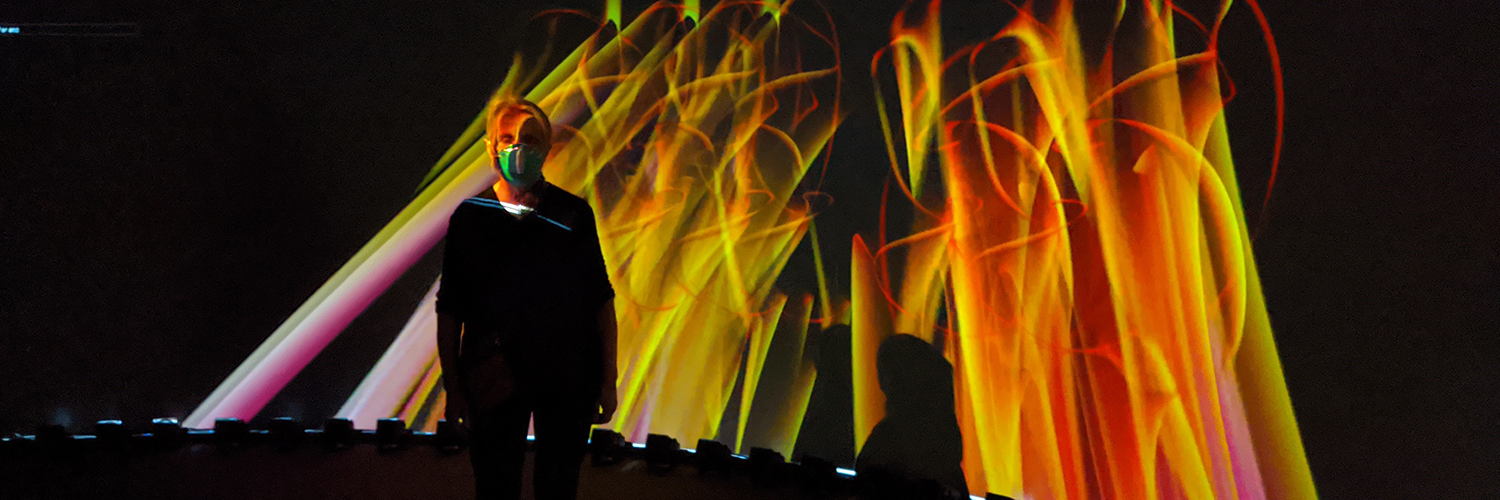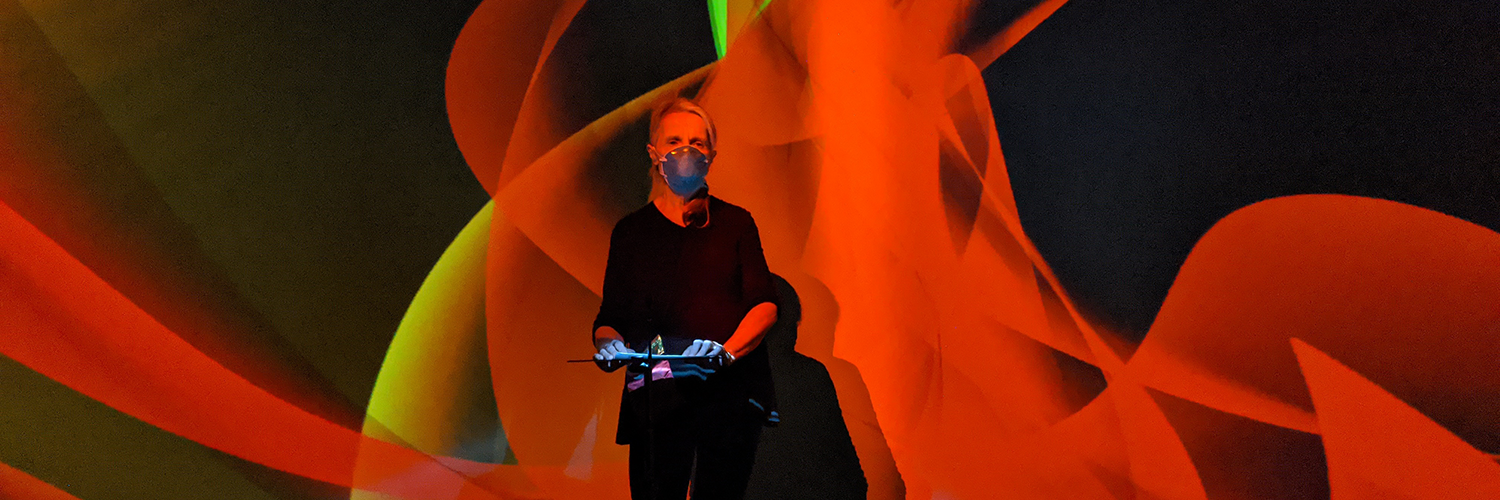
A Message from Dr. Kuchera-MorinLearn more
Dr. JoAnn Kuchera-Morin, chief designer of the facility, composer, and media artist with over thirty filve years of experience in media systems engineering, outlines the vision for our research.




 Hydrogen in Sphere 1
Hydrogen in Sphere 1
 Hydrogen in Sphere 2
Hydrogen in Sphere 2
Like viewing the waves upon the ocean and watching the various shapes that they form when different ocean currents intertwine, the hydrogen-like atom’s ocean is the vast sea of all of the places that its electron can intertwine and become like waves upon its vast ocean.
As the different currents in the ocean intersect and come together to make the beautiful patterns that one sees as these waves, and the various shapes that seaweed and other particles make flowing over these currents, so we have made it possible for you to see and hear these shapes of the hydrogen-like atom’s waves. These waves arise as a combination of different fundamental waveforms, just as a chord arises from a combination of different notes.
By tracking these wave combinations through the hydrogen ocean currents, using a visual and sonic “rubber band” that coils among these currents, we can see and hear these lovely and interesting shapes, in the hydrogen-like atom’s ocean. The rubber band is visually colored with the hue of the rainbow, its hue and thickness is tracking the spin of the electron. The electron behaves as if it were spinning like a top as it moves around from place to place.
We have combined two to three wave functions to make 9 objects that can be connected and made into visual and sonic compositions. These shapes have names: WhirlWing, Rose, MomentarySpires, Fine, Filaments, Ghost, Spool-UnSpool, Floating Sail, and are compellingly reminiscent of what they look like.
How do we know how to “find” the electron? Where do we find the coordinates to track the electron as it “makes” these waves?
Just like there are numbers that relate to coordinates on a map that tell you your location, there are a total of four quantum numbers to describe completely the movement and trajectories of each electron within an atom. The combination of these four quantum numbers gives you the location and shape of the electron’s path as it moves through the hydrogen ocean.
The four quantum numbers include: 1) the principal quantum number (n) that describes the distance of the electron from the center (nucleus) of the atom, 2) the orbital angular momentum quantum number (l) that describes the shape of the orbital, 3) the magnetic quantum number (ml) that describes the energy levels, and 4) and (ms) that refers to the spin on the electron, which can either be up or down.
For a deeper explanation refer to: http://chem.libretexts.org/Core/Physical_and_Theoretical_Chemistry/Quantum_Mechanics/10%3A_Multi-electron_Atoms/Quantum_Numbers
The numbers that we use to track the various shape combinations are (n), (l), and two numbers that combine ml and ms to denote the total angular momentum of the electron, J and j. Two other numbers are also important: w that says how much of the wave is present and f that says how quickly the wave is moving.
All of these numbers can be moved and interacted with on our visual and sonic instrument to allow you to compose various shapes and forms visually and sonically over time.
Here are the 9 basic wave function combinations that we have named above and their quantum numbers describing their shapes.
 Fine
Fine
 Whirlwing
Whirlwing
 Rose
Rose
 Floating Sail
Floating Sail
 Filaments
Filaments
 Flowers
Flowers
 Momentary Spires
Momentary Spires
 Spool/Unspool
Spool/Unspool
 Ghost
Ghost
Just as the quantum numbers give rise to the different visual shapes that one sees above, and these shapes move over time as the “rubber band” curls through the different wave combinations of the electron, the rubber band’s movement can also be heard sonically.
Just as there are visual colors showing the electron’s spin among the various wave combinations, we can hear different sound colors as we change from one wave function combination to another. Think of these sound colors as one thinks of various sound colors of instruments in an orchestra like flutes and violins. If one thinks of the instrument of the pipe organ, an organ can make different sound colors like flutes and violins and these are called the organ flute and violin pipe “stops”. These sound colors are made in the organ by combining various pitches also called frequencies that move at different speeds and amplitudes, within the various pipes of the organ. We have made our visual and sonic hydrogen organ so that we can control these sound color combinations through the f and w numbers on our organ controller. The different sound colors we hear when we change from, for instance, the Flowers “pipe organ stop” to the WhirlWing “pipe organ stop”, is analogous to the different sound colors of flutes and violins that one has when one changes from the “flute stop” to the “violin stop” on a pipe organ. The f number combinations in the controls parameters of the wave function numbers can cause the sound color to have “faster or slower” motion, even to a beating sound among the various f numbers being combined. The w number combinations will tell you how strong each of the f numbers sound. This gives the overall tone color of the shape being viewed. Now one can connect these various “pipes” (wavefunctions) to a keyboard and play them like a pipe organ. Not only will we hear the shapes but we will see them as well. We can now perform these shapes interactively in live visual and sonic compositions.
So the (n) and (l) quantum numbers control the size and shape (how far away from the nucleus and the shape of the path). These values also control the overall sound of each wavefunction combination. The J/j values control the width and color of the rubber band and the f and w numbers control the visual/sonic color speed and amplitude. Moving these sliders and buttons on the virtual interface will allow you to change the shapes and the sounds. In the Compose and Perform Section you will learn how to record and perform you own visual/sonic piece.
PROBABLY/POSSIBLY? Is a visual and sonic composition composed and performed for the Hydrogen-Like Atom instrument described above. The work explores the currents of an electron in the ocean of a hydrogen atom, using the various wave function combinations described above. The beautiful visual and sonic patterns that one hears and sees are the paths that these particles take connected as a “rubber band”, while navigating the hydrogen ocean. The colors in PROBABLY/POSSIBLY? are mapped differently and hence do not give the rainbow effect as in the original hydrogen shapes.
The first movement, PROBABLY, uses the basic shapes of WhirlWing, Momentary Spires, Fine, and various transformations of these shapes as the material that forms this movement. In a typical classical sonata form the shapes are exposed in two different themes that are then developed through a section that morphs these shapes and forms visually and sonically over time to return to its recapitulation, a slightly varied return of the two themes. In navigating the shapes in the first movement, one is primarily outside of the figures but then one becomes drawn inside as the movement progresses.
The Second movement, POSSIBLY?, contains transformations of FloatingSail, Rose, Filaments and Ghost as well as the shapes from the first movement. There is one appearance of Flowers right before the climatic section of this movement. This movement is in an arch-like form. In navigating the shapes of the second movement. One is primarily immersed inside of the composition.
PROBABLY/POSSIBLY? is being installed in the purpose built Media Theater at Santa Barbara's Museum of Exploration and Innovation. The Media Theater features a large scale curved screen and active stereo projectors.
 View of Curved Screen inside Media Theatre
View of Curved Screen inside Media Theatre
 Top Diagonal View of Media Theatre
Top Diagonal View of Media Theatre
 View of Curved Screen and Projector Placement inside Media Theatre
View of Curved Screen and Projector Placement inside Media Theatre
Users can interact with the hydrogen-like atom installation using a touch screen and mobile devices. The user interface exposes parameters of the simulation and of the visual and aural rendering and it allows users to compose pieces through sequencing state presets.
 A Screenshot of User Interface
A Screenshot of User Interface